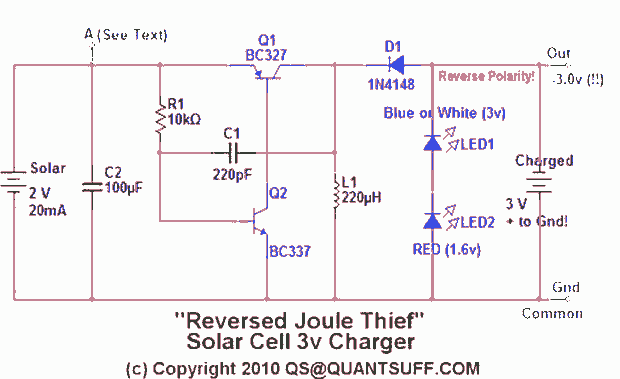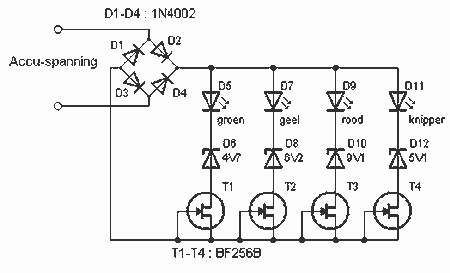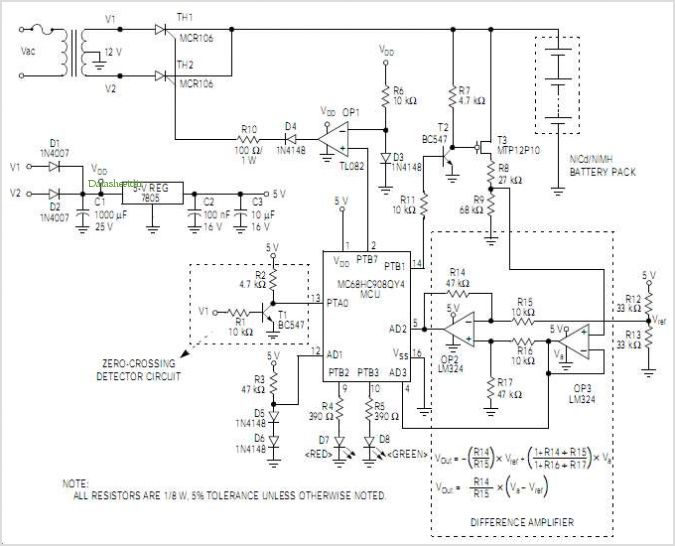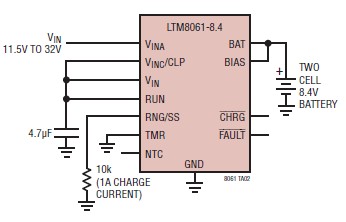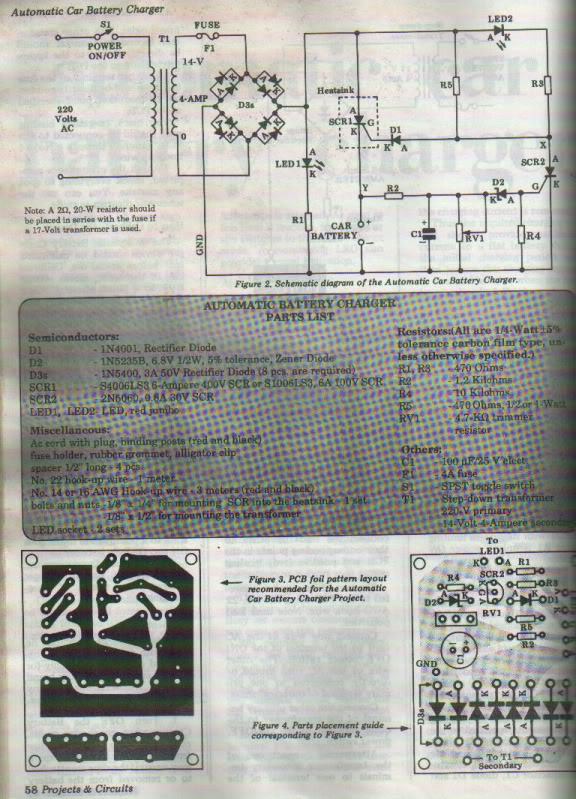
Nicad / NiMh Battery charger
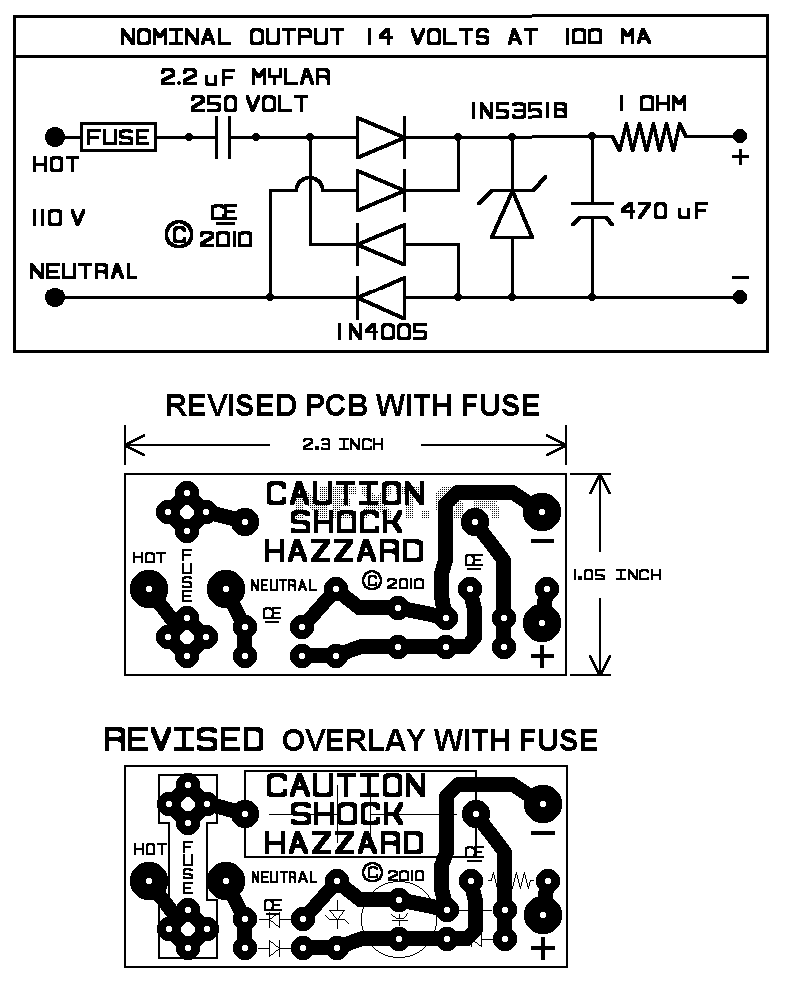
Using this circuit will give good charging results to a sealed lead acid battery, like I use in the metal detector. This circuit is extremely small in size and has a low parts count, making it ideal in some situations. It can also be adapted for charging nicads. This charger is both current and voltage regulated and the output is short circuit protected. The 1 Ohm resistor is a fusing resistor, protecting the battery in case a short occurs. With the 2.2 ufd capacitor, it will produce an output of about 100 mA. A capacitor of 1 ufd will produce an output of about 50 mA. The Zener used here is rated at 14 Volt and 5 Watts. More: Do not use a lower wattage Zener. For charging a 12 Volt nicad or NiMH battery, use a capacitor to produce a current of 1/10 battery capacity. (For a 1000 mA/h battery, the 2.2 uF is suitable.) But use a 1N5352B Zener, as this Zener has a 15 Volt rating. Normal charge time at 1/10 capacity is 16 hours. But it won't overcharge or overheat your batteries. The fuse on this board is a "European" type, as they are smaller and fit the board better. The fuse is a 1 Amp rating or smaller.
The described circuit serves as a compact and efficient charger for sealed lead-acid batteries, with the potential for adaptation to nickel-cadmium (NiCd) and nickel-metal hydride (NiMH) batteries. It features both current and voltage regulation, ensuring safe and controlled charging, which is critical for battery longevity and performance.
The main components of the circuit include a Zener diode, which acts as a voltage regulator, a fusing resistor, and capacitors that determine the output current. The Zener diode specified is rated at 14 volts and 5 watts, which is essential for maintaining the appropriate voltage level during the charging process. It is advised to use a higher-rated Zener, such as the 1N5352B, which has a 15-volt rating when charging NiCd or NiMH batteries, to prevent damage due to overvoltage.
The fusing resistor, with a value of 1 ohm, provides a critical safety feature by limiting the current in the event of a short circuit, thereby protecting the battery and other circuit components. The circuit can generate an output of approximately 100 mA when using a 2.2 µF capacitor, while a 1 µF capacitor will yield around 50 mA. This output current is designed to be 1/10 of the battery's capacity, which is a standard charging method to avoid overheating and overcharging. For example, a battery with a capacity of 1000 mA/h would be suitably charged with the 2.2 µF capacitor.
The design also incorporates a fuse rated at 1 amp or lower, which is a smaller European type that fits the board better, ensuring that the circuit is protected from excessive current draw. The overall design emphasizes compactness and efficiency, making it suitable for applications where space is limited, such as in portable devices like metal detectors. By adhering to the specified component ratings and configurations, the circuit can provide reliable charging without the risk of damaging the batteries.Using this circuit will give Good Charging results to a Sealed Lead Acid Battery, like I use in the Metal Detector. This Circuit is Extremely Small in size and has a low parts count, making it ideal in some situations.
It can also be adapted for Charging Nicads. This charger is both Current and Voltage Regulated and the Output is short circuit protected. The 1 Ohm resistor is a Fusing Resistor, Protecting the battery in case a short occurs. With the 2.2 ufd capacitor it will produce an output of about 100 Ma. A capacitor of 1 ufd will produce an output of about 50 Ma. The Zener used here, is rated at: 14 Volt and 5 Watts. Do Not use a lower wattage Zener. For Charging a 12 Volt Nicad or NiMh Battery, use a capacitor to produce a current of 1/10 battery Capacity. (for a 1000 MA/H Battery, the 2.2 uf is suitable.) But use a 1N5352B Zener, as this zener has a 15 Volt Rating.
Normal Charge Time at 1/10 capacity is 16 hours. But it Won't over charge or Over Heat your batteries. The Fuse on this board is a "European" type, as they are smaller and fit the board better. Fuse is a 1 Amp rating or Smaller. 🔗 External reference
The described circuit serves as a compact and efficient charger for sealed lead-acid batteries, with the potential for adaptation to nickel-cadmium (NiCd) and nickel-metal hydride (NiMH) batteries. It features both current and voltage regulation, ensuring safe and controlled charging, which is critical for battery longevity and performance.
The main components of the circuit include a Zener diode, which acts as a voltage regulator, a fusing resistor, and capacitors that determine the output current. The Zener diode specified is rated at 14 volts and 5 watts, which is essential for maintaining the appropriate voltage level during the charging process. It is advised to use a higher-rated Zener, such as the 1N5352B, which has a 15-volt rating when charging NiCd or NiMH batteries, to prevent damage due to overvoltage.
The fusing resistor, with a value of 1 ohm, provides a critical safety feature by limiting the current in the event of a short circuit, thereby protecting the battery and other circuit components. The circuit can generate an output of approximately 100 mA when using a 2.2 µF capacitor, while a 1 µF capacitor will yield around 50 mA. This output current is designed to be 1/10 of the battery's capacity, which is a standard charging method to avoid overheating and overcharging. For example, a battery with a capacity of 1000 mA/h would be suitably charged with the 2.2 µF capacitor.
The design also incorporates a fuse rated at 1 amp or lower, which is a smaller European type that fits the board better, ensuring that the circuit is protected from excessive current draw. The overall design emphasizes compactness and efficiency, making it suitable for applications where space is limited, such as in portable devices like metal detectors. By adhering to the specified component ratings and configurations, the circuit can provide reliable charging without the risk of damaging the batteries.Using this circuit will give Good Charging results to a Sealed Lead Acid Battery, like I use in the Metal Detector. This Circuit is Extremely Small in size and has a low parts count, making it ideal in some situations.
It can also be adapted for Charging Nicads. This charger is both Current and Voltage Regulated and the Output is short circuit protected. The 1 Ohm resistor is a Fusing Resistor, Protecting the battery in case a short occurs. With the 2.2 ufd capacitor it will produce an output of about 100 Ma. A capacitor of 1 ufd will produce an output of about 50 Ma. The Zener used here, is rated at: 14 Volt and 5 Watts. Do Not use a lower wattage Zener. For Charging a 12 Volt Nicad or NiMh Battery, use a capacitor to produce a current of 1/10 battery Capacity. (for a 1000 MA/H Battery, the 2.2 uf is suitable.) But use a 1N5352B Zener, as this zener has a 15 Volt Rating.
Normal Charge Time at 1/10 capacity is 16 hours. But it Won't over charge or Over Heat your batteries. The Fuse on this board is a "European" type, as they are smaller and fit the board better. Fuse is a 1 Amp rating or Smaller. 🔗 External reference
